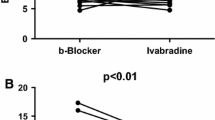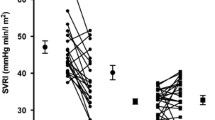Abstract
Impaired endothelium-dependent vasodilatation of coronary resistance vessels has been demonstrated in patients with hypertrophic cardiomyopathy (HC). The aim of this study was to compare the effect of verapamil and propranolol on the response of diastolic coronary blood flow velocity (CBFV) and coronary vascular resistance index to the cold pressor test (CPT) in symptomatic HC patients. In 15 patients with HC, the CBFV was measured in the distal portion of the left anterior descending coronary artery using high-sensitivity transthoracic Doppler echocardiography. Peak diastolic CBFV and coronary vascular resistance index (calculated as ratio of mean aortic pressure/CBFV ratio) were measured at baseline and after CPT. Changes of these parameters induced by the CPT (expressed as percentage of baseline values) were compared after verapamil and propranolol treatment in a crossover study. The same measurements were obtained in nine healthy control subjects. CPT induced an increasing pattern of CBFV during verapamil therapy, which was absent in CPT after propranolol administration (10.1 ± 5.6% vs. −0.9 ± 4.1%, P < 0.01). In healthy controls CBFV increased in response to CPT more than in HC patients receiving verapamil or propranolol (23.1±12.8% P < 0.01 and P < 0.05, respectively). The coronary vascular resistance index increased during the CPT significantly less on verapamil than on propranolol treatment (3.5 ± 9.2% vs. 18.1 ± 13.5%, P < 0.01). In healthy controls the coronary vascular resistance index decreased during CPT −4.5 ± 8.5% (P < 0.05 vs. verapamil and P < 0.01 vs. propranolol). Verapamil improved the coronary vasomotor response to CPT in relation to propranolol. Verapamil blunted the increase of the coronary vascular resistance index to the CPT in comparison with its change at CPT after propranolol. Thus, coronary endothelial dysfunction in symptomatic HC patients may be partially reduced by verapamil in comparison with propranolol treatment.
Similar content being viewed by others
References
Spirito P, Seidman Ch, McKenna WJ, Maron BJ. The management of hypertrophic cardiomyopathy. N Engl J Med 1997;336:775-785.
Kaltenbach M, Hopf R, Kober G, Bussmann WD, Keller M, Petersen Y. Treatment of hypertrophic cardiomyopathy with verapamil. Br Heart J 1979;42:35-42.
Kober G, Hopf R, Biamino G, et al. Long-term treatment of hypertrophic cardiomyopathy with verapamil or propranolol in matched pairs of patients: Results of a multicenter study. Z Kardiol 1987;76 (Suppl. 3):113-118.
Maron BJ, Bonow RO, Cannon RO, Leon MB, Epstein SE. Hypertrophic cardiomyopathy: Interrelations of clinical manifestations, pathophysiology and therapy. N Engl J Med 1987;316:780-789,844-852.
Rosing DR, Kent KM, Maron BJ, Epstein SE. Verapamil therapy: A new approach to the pharamcologic treatment of hypertrophic cardiomyopathy: II Effects on exercise and symptomatic status. Circulation 1979;60:1208-1213.
Bonow RO, Rosing DR, Bacharach SL, et al. Effects of verapamil on left ventricular systolic function and diastolic filling in patients with hypertrophic cardiomyopathy. Circulation 1981;64:787-796.
Hess OM, Grimm J, Krayenbuehl HP. Diastolic function in hypertrophic cardiomyopathy: Effects of propranolol and verapamil on diastolic stiffness. Eur Heart J 1983;4 (Suppl. F):47-56.
Bonow RO, Dilsizian V, Rosing DR, Maron BJ, Bacharach SL, Green MV. Verapamil-induced improvement in left ventricular diastolic filling and increased exercise tolerance in patients with hypertrophic cardiomyopathy: Short-and long-term effects. Circulation 1985;72:853-864.
Losse B, Loogen F, Schulte HD. Hemodynamic long-term results after medical and surgical therapy of hypertrophic cardiomyopatthies. Z Kardiol 1987;76 (Supp. 3): 119-130.
Dilsizian V, Bonow RO, Epstein SE, Fananapazir L. Myocardial ischemia detected by thallium scintigraphy is frequently related to cardiac arrest and syncope in young patients with hypertrophic cardiomyopathy. J Am Coll Cardiol 1993;22:796-804.
Udelson JE, Bonow RO, O'Gara PT, et al. Verapamil prevents silent myocardial perfusion abnormalities during exercise in asymptomatic patients with hypertrophic cardiomyopathy. Circulation 1989;79:1052-1060.
Maron BJ, Wolfson JK, Epstein SE. Intramural ("small vessel") coronary disease in hypertrophic cardiomyopathy. J Am Coll Cardiol 1986;8:545-547.
Tanaka M, Fujiwara H, Onodera T, et al. Quantitative analysis of narrowings of intramyocardial small arteries in normal hearts, hypertensive hearts, and hearts with hypertrophic cardiomyopathy. Circulation 1987;75:1130-1139.
Schwartzkopff B, Mundhenke M, Strauer BE. Alterations of architecture of subendocardial arterioles in patients with hypertrophic cardiomyopathy and impaired coronary vasodilator reserve: A possible cause for myocardial ischemia. J Am Coll Cardiol 1998;31:1089-1096.
Krams R, Kofflard MJ, Duncker DJ, et al. Decreased coronary flow reserve in hypertrophic cardiomyopathy is related to remodeling of the coronary microcirculation. Circulation 1998;97:230-233.
Choudhury L, Elliott P, Rimoldi O, et al. Transmural myocardial blood flow distribution in hypertrophic cardiomyopathy and effect of treatment. Basic Res Cardiol 1999;94:49-59.
Gistri R, Cecchi F, Choudhury L, et al. Effect of verapamil on absolute myocardial blood flow in hypertrophic cardiomyopathy. Am J Cardiol 1994;74:363-368.
Kaufmann Ph, Frielingsdorf J, Mandinov L, Seiler Ch, Hug R, Hess OM. Reversal of abnormal coronary vasomotion by calcium antagonists in patients with hypercholesterolemia. Circulation 1998;97:1348-1354.
Frielingsdorf J, Kaufmann Ph, Seiler Ch, Vassalli G, Suter T, Hess OM. Normalization of abnormal coronary vasomotion by calcium antagonists in patients with hypertension. Circulation 1996;93:1380-1387.
Nabel EG, Ganz P, Gordon JB, Alexader RW, Selwyn AP. Dilatation of normal and constriction of atherosclerotic coronary arteries caused by the cold pressor test. Circulation 1988;77:43-52.
Zeiher AM, Drexler H, Wollschlager H, Just H. Modulation of coronary vasomotor tone: Progressive endothelial dysfunction with different early stages of coronary atherosclerosis. Circulation 1991;83:391-401.
Zeiher AM, Drexler H, Wollschlager H, Just H. Endothelial dysfunction of the coronary microvasculature is associated with impaired coronary blood flow regulation in patients with early atherosclerosis. Circulation 1991; 84:1984-1992.
Zeiher AM, Drexler H, Wollschlager H, Saurbier B, Just H. Coronary vasomotion in response to sympathetic stimulation in humans: Importance of the functional integrity of the endothelium. J Am Coll Cardiol 1989;14:1181-1190.
Kern MJ, Ganz P, Horowitz JD, et al. Potentiation of coronary vasoconstriction by beta-adrenergic blockade in patients with coronary artery disease. Circulation 1983;67:1178-1185.
Kodama K, Hamada M, Kazatani Y, et al. Clinical characteristics in Japanese patients with coexistent hypertrophic cardiomyopathy and coronary vasospasm. Angiology 1998;49:849-855.
Petkow Dimitrow P, Krzanowski M, Nizankowski R, Szczeklik A, Dubiel J. Verapamil improves the response of coronary vasomotion to cold pressor test in asymptomatic and mildly symptomatic patients with hypertrophic cardiomyopathy. Cardiovasc Drug Ther 1999;13:259-264.
Iida H, Fujii T, Miura T, Yoshitake S, Kawamura A, Fujii A. Assessment of endothelium dependent coronary vasodilatation in hypertrophic cardiomyopathy (abstr). Circulation 1996;94:I-502.
Report of World Health Organization/International Society and Federation of Cardiology Task Force on the definition and classification of cardiomyopathies. Circulation 1996;93:841-842.
Maron BJ, Epstein SE. Hypertrophic cardiomyopathy: A discussion of nomenclature. Am J Cardiol 1979;43:1242-1244.
Crowley JJ, Dardas PS, Harcombe AA, Shapiro LM. Transthoracic Doppler echocardiographic analysis of phasic coronary blood flow velocity in hypertrophic cardiomyopathy. Heart 1997;77:558-563.
Hozumi T, Yoshida K, Akasaka T, et al. Noninvasive assessment of coronary flow velocity and coronary flow velocity reserve in the left anterior descending coronary artery by Doppler echocardiography. Comparison with invasive technique. J Am Coll Cardiol 1998;32:1251-1259.
Caiati C, Montaldo C, Zedda N, Bina A, Iliceto S. New noninvasive method for coronary flow reserve assessment: Contrast-enhanced transthoracic second harmonic echo Doppler. Circulation 1999;99:771-778.
Ishihara M, Sato H, Tateishi H, et al. Effects of various doses of intracoronary verapamil on coronary resistance vessels in humans. Jpn Circ J 1997;61:755-761.
Antony G, Nitenberg A, Foult J-M, Aptecar E. Coronary vasodilator reserve in untreated and treated hypertensive patients with and without left ventricular hypertrophy. J Am Coll Cardiol 1993;22:514-520.
Rossen JD, Nahser PJ, Oskarsson H, et al. Does pharmacologic coronary flow reserve reflect vasodilator responsiveness to increased myocardial demand in humans? Cor Art Dis 1996;7:479-484.
Parodi O, Neglia D, Palombo C, et al. Comparative effects of enalapril and verapamil on myocardial blood flow in systemic hypertension. Circulation 1997;96:864-873.
Dubois-Rande JL, Dupouy P, Aptecar E, et al. Comparison of the effects of exercise and cold pressor test on the vasomotor response of normal and atherosclerotic coronary arteries and their relation to the flow-mediated mechanism. Am J Cardiol 1995;76:467-473.
Ismail Y, Abdelmessih NK, Wong I, et al. Effect of nitric oxide synthesis inhibition on the coronary sinus blood flow response to the cold pressor test: Evaluation by transthoracic echocardiography (abstr). Circulation 1996;94:I-592.
Kern MJ, Petru MA, Ferry DR, et al. Regional coronary vasoconstriction after combined beta-adrenergic and calcium channel blockade in patients with coronary artery disease. J Am Coll Cardiol 1985;5:1438-1450.
Dehmer GJ, Winniford MD, Hillis LD, Markham RV, Firth BG. The myocardial oxygen/demand ratio in patients with and without coronary artery disease. Cathet Cardiovasc Diagn 1982;8:469-479.
Campisi R, Czernin J, Schoder H, Sayre JW, Schelbert HR. L-arginine normalizes coronary vasomotion in long-term smokers. Circulation 1999;99:491-497.
Takase H, Moreau P, Kung Ch, Nava E, Luscher TF. Antihypertensive therapy prevents endothelial dysfunction in chronic nitric oxide deficiency, effect of verapamil and trandolapril. Hypertension 1996;27:25-31.
Dagenais F, Cartier R, Hollmann C, Buluran J. Calcium-channel blockers preserve endothelial reactivity after ischemia-reperfusion. Ann Thorac Surg 1997;63:1050-1056.
Shibata K, Hirasawa A, Foglar R, Ogawa S, Tsujimoto G. Effects of quinide and verapamil on human cardiovascular alpha 1-adrenoceptors. Circulation 1998;97:1227-1230.
Bronztti E, Felici L, Polidori C, Amenta F. Interactions between calcium channel blockers and alpha-adrenoceptors in the human coronary and mammary arteries: A radioligand binding study. J Auton Pharmacol 1994;14:79-85.
Vita JA, Treasure ChB, Yeung AC, et al. Patients with evidence of coronary endothelial dysfunction as assessed by acetylcholine infusion demonstrate marked increase in sensitivity to constrictor effects of catecholamines. Circulation 1992;85:1390-1397.
Baumgart D, Haude M, Gorge G, et al. Augmented ?-adrenergic constriction of atherosclerotic human coronary arteries. Circulation 1999;99:2090-2097.
Bassenge E, Stewart DJ. Interdependence of pharmacologically-induced and endothelium-mediated coronary vasodilatation in antianginal therapy. Cardiovasc Drugs Ther 1988;1:47-55.
Dohi Y, Criscione L, Pfeiffer K, Luscher TF. Angiotensin blockade or calcium antagonists improve endothelial dysfunction in hypertension: Studies in perfused mesenteric resistance arteries. J Cardiovasc Pharmacol 1994;24:372-379.
Ritz MA, Luscher TF. Different potencies of endothelium-derived relaxing factors against thromboxane and endothelin-1 in coronary arteries: Comparison with nitrovasodilator and calcium antagonists. Cor Art Dis 1991;2:1001-1008.
Haug C, Voisard R, Baur R, Hannekum A, Hombach V, Gruenert A. Effect of diltiazem and verapamil on endothelin release by cultured human coronary smooth-muscle cells and endothelial cells. J Cardiovasc Pharmacol 1998;31(Suppl. 1):S388-S391.
Wilson RF, Laughlin De, Ackell PH, et al. Transluminal subselective measurement of coronary artery flow velocity and vasodilator reserve in man. Circulation 1985;72: 82-92.
Reis SE, Holubkov R, Lee JS. Coronary flow velocity response to adenosine characterizes coronary microvascular function in women with chest pain and no obstructive coronary disease. Results from the pilot phase of the Women's Ischemia Syndrome Evaluation (WISE) study. J Am Coll Cardiol 1999;33:1469-1475.
Author information
Authors and Affiliations
Rights and permissions
About this article
Cite this article
Dimitrow, P.P., Krzanowski, M., Nizankowski, R. et al. Comparison of the Effect of Verapamil and Propranolol on Response of Coronary Vasomotion to Cold Pressor Test in Symptomatic Patients with Hypertrophic Cardiomyopathy. Cardiovasc Drugs Ther 14, 643–650 (2000). https://doi.org/10.1023/A:1007871032421
Issue Date:
DOI: https://doi.org/10.1023/A:1007871032421




